Angus William McCallum’s Adventures in the Early Days of Edmonton
I have been a member of the consistently excellent Historic Edmonton and Northern Alberta Facebook group for several years. Recently, one of the members shared a photo from a car accident that occurred 95 years ago in 1929 in Edmonton.
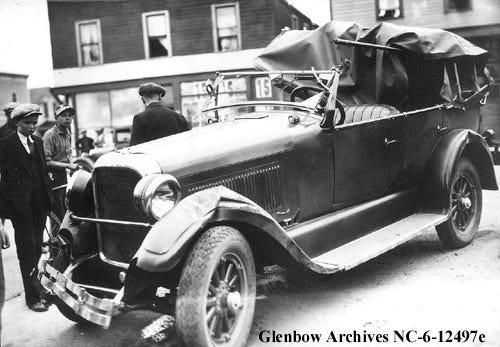
The car accident involved a young man named Angus William McCallum, who had been driving recklessly through downtown with a passenger, Alfred Joseph “Dave” Gaucher (son of Rene and Mary Louisa Gaucher).1 The accident led to Gaucher being thrown from the car and seriously injured, William being knocked unconscious and injured himself, and ultimately charges against William for reckless driving.
I found myself asking: what kind of 21-year-old kid has access to a car in 1929, and I wonder what happened to him afterwards?
A Bad Boy?
William McCallum, born in 1907, was the son of J.S. McCallum (Joseph Seely), an early settler in the town of Mundare and later a Member of the Legislative Assembly in Alberta. McCallum operated a number of businesses, including McCallum Motors, which dealt in Studebaker and other cars during the late 1920s. (The car William was driving at the time of the accident was a Studebaker, incidentally.)
On July 20, 1927, William travels to Portland with the intention of immigrating there permanently.

William appears to have been in Portland for only a handful of weeks when he is involved in a pretty terrifying crime: he’s held up by a “thug,” who shot and then robbed him. Apparently, the man told William to put up his hands, and he instead grappled with the robber. The man shot him downwards through his shoulder, possibly piercing a lung. The man then stole the $100 that William brought with him and left him bleeding on the road. William’s father travels down to get his boy and bring him home.
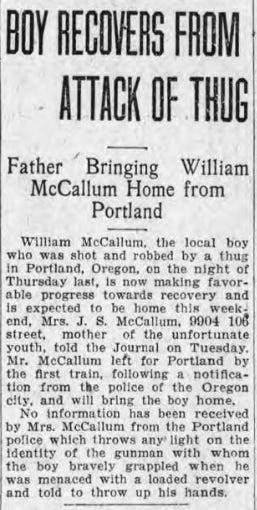
It isn’t clear whether “thug shoots boy” is the whole story from William’s adventure in Portland. A couple of incidents that occur not too long after his time there suggest William himself may have had a rougher edge.
Two years later, before he’s on trial for the car accident, he’s already wound up in court for a completely different reason.2
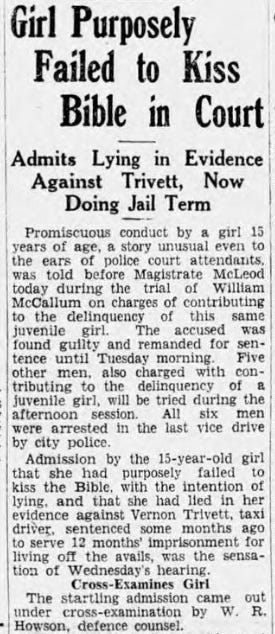
We see in a February 23, 1929 article in the Edmonton Journal that William has been sentenced to 4 months in jail for his role in a “vice” ring. Specifically, he was found guilty of “contributing to the delinquency of Miss L.” He plans to appeal his sentence. It isn’t clear whether he is able to make bail. (This episode in Edmonton’s history is sort of wild and would be interesting to do a post on all by itself. In the end, the “vice ring” drive led to at least 46 arrests with 50 charges.)
He must have had his sentence at least somewhat reduced as the next time he is in the paper is less than four months later — this time due to the major car accident that he causes.
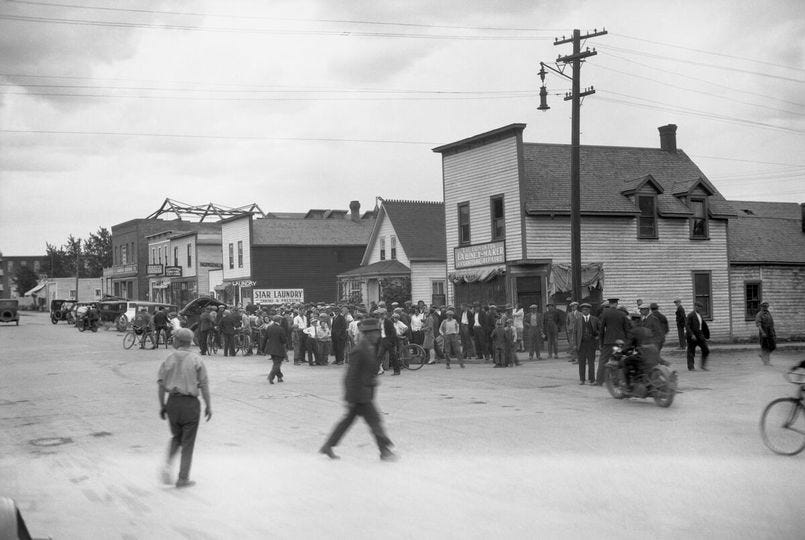
The accident is pretty wild: William is taking his friends for spins downtown, driving 50-60 miles an hour, along what is essentially a residential street. He passes a police officer on a motorcycle and the officer later says, “he pulled his cap down over his eyes […] so that I might not be able to recognize him” (Edmonton Journal, August 8, 1929). This line takes on a new significance given William’s earlier (but quite recent!) involvement in the “vice” ring.
Both William and Gaucher are drunk. William Allan McBain, attempting to pass a team and wagon, is travelling in the opposite direction in the lane that William is in. He sees William coming his way. But, despite his best attempts, he cannot avoid him. William hits McBain, sending the latter’s car 42 feet and William’s car 69 feet. Another article indicates that at least one of the vehicles rolls over before landing upright again. Both William and Gaucher are knocked unconscious. William is charged with wilful misconduct and causing grievous bodily harm.
Initially, William pleas not guilty. About a month later, though, he asks for permission to change his plea to guilty. His counsel says that “the youth needed discipline, but was not bad.” At first, the judge is open to this and hopes to find a way to avoid imposing jail time.
This changes, though, when William gets in yet another accident — less than a week before his sentencing. This time he runs his motorcycle into the back of a car on Jasper Avenue.
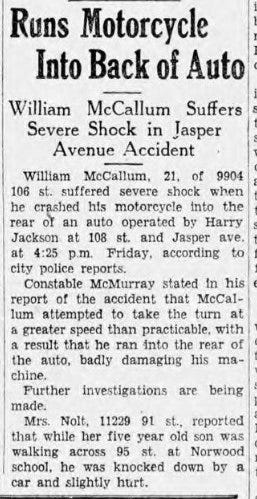
Presumably, he got the motorcycle from his father.
The judge appears to take this second reckless act as well as William’s earlier arrest with the vice ring into account when he says, “Your counsel has stated that you are not a bad boy but your record disproves that. It is a bad record for a boy of your years.”
He is sentenced to two months in jail. Assuming that he served his time, he would be out well before Christmas 1929.
Things get a little fuzzy here. In mid-1930, William goes over the border with his friend Paul (Shep) Kaplain to visit Paul’s brother Jake Kaplain, who lives in California. The immigration manifest indicates that he is planning to reside in the U.S. permanently. (I am not quite sure how he is able to get into the States at all given that he has a criminal record.) By 1931, though, he is back in Edmonton, where he gets married.
William’s struggles behind the wheel are sadly not over yet. In June 1932, another report appears in the Edmonton Journal that one, “William McCallum, Mundare,” has caused another car crash due to being intoxicated while driving. He spends a few days in jail for this.
Notably, in 1932, William’s father, J.S. McCallum appears to have gone bankrupt.
A New Leaf
Things begin to change for William, though, with the war. He’s 32 years old when the Second World War starts. He joins the Royal Canadian Engineers. Ultimately, at least two other brothers join the war effort. He makes it through the war as do his other siblings.
When he returns, he appears to have determined to turn over a new leaf. By 1953, he is listed as a civil servant working with the Government of Alberta. A review of the Edmonton phone directories, which often list the occupation of the resident, show him moving through a variety of clerk and more senior positions, ultimately retiring as an inspector. William greatly valued his time in the military, serving as a member of the Royal Canadian Legion and Veterans Association for several decades.
William passed away in 1988 at the age of 81.

One more quick story.
In 1957, a person named Joseph McCallum, who may be Angus’s younger brother, but is more likely Angus’s son, is listed as living with Angus and his wife, Nettie. He is listed at the time as the music director for CFRN radio. A few years earlier, a person also named Joe McCallum shows up as a radio announcer at CJOC in Lethbridge. As a man whose father appeared so often in the print media of his day, it is interesting that Joseph McCallum would choose to enter the world of the new medium of radio. Perhaps the decision was unrelated. Here’s an amazing picture of Joseph (he’s on the left, fortunately):

- Gaucher does go on to make a recovery from his injuries, but sadly tragedy strikes again many years later when his only child, Rene Alfred Gaucher (named after his father and grandfather), dies of a gunshot wound at the tender age of 7. He had been accompanying his father and his friend on a rabbit-hunting expedition. The gun was propped between the driver and the passenger and accidentally went off. ↩︎
- This part of the story is bizarre. The girl in the court case, on the stand, admits: “I didn’t kiss the Bible because I didn’t intend to tell the truth.” The defence asks her if the man they are discussing is in jail because of her lies. She responds: “Well, not exactly. If I had told the truth he would have got more than he did.” ↩︎